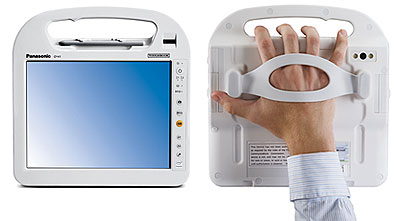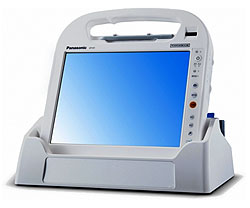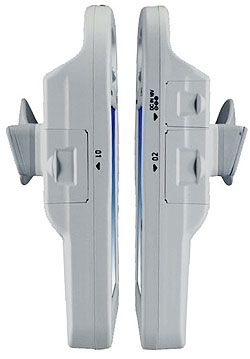|
Panasonic Toughbook H1
Mobile Clinical Assistant
(by Conrad H. Blickenstorfer)
On November 4, 2008 -- Election Day in the United States -- Panasonic introduced the Toughbook H1 Mobile Clinical Assistant. It's an elegantly designed product for a market that Panasonic expects to be a key player in, and one the company optimistically expects to be among their largest sales segments within three years or so.

What do you do when you're trying to enter a field that's hugely promising but where the competition has a significant head start? That's the situation Panasonic finds itself in with their new Toughbook H1 Mobile Clinical Assistant for Medical Professionals. The competition, of course, is Motion Computing's C5, a machine that's been quite well received. Panasonic's task therefore is to convince medical sector customers that the new H1 is worthy of their consideration. So before I go into a description of the Panasonic H1, let's look at Panasonic's arguments:
First of all, there is Panasonic's reputation as a one-stop shop with many years of experience. Panasonic practically established the rugged and semi-rugged market with its line of Toughbooks, and the company covers all bases and form factors so there is no need to buy tablets from one vendor and notebooks from another. Whatever mobile solution is needed, Panasonic likely has a product to fill the need.
Second, it's not always good to be first. No matter how carefully they research a market, pioneers always take a chance and may miss the mark either with the concept or with details. Panasonic therefore had the advantage of seeing feedback to the Motion C5 and use that in their design decisions.
Finally, technology never stands still and it's easier to incorporate the latest and greatest into a new design than retrofitting an existing one.
Panasonic also did their own research that guided them in the development process of the H1. A customer survey conducted at the Panasonic Healthcare Mobile Technology Symposium 2007 showed that only 16% were satisifed with their current device. Reasons given for satisfaction were insufficient battery life (29%); disinfection, ruggedness, and infection control with 17% each; and excessive heat generation (4%). It should come as no surprise that Panasonic addressed these issues in their own Mobile Clinical Assistant product.
As a result, Panasonic designed the H1 to be:
- Rugged (3 foot drop, etc.)
- Fully sealed for easier and better sanitization (fanless design, no holes, etc.)
- Refined ergonomics (rearranged controls, added handstrap, dual digitizers etc.)
- Long battery life
On the technology side, the H1 uses an Intel Atom Z540 processor and can thus claim a much faster clockspeed than the competition as well as the extremely low thermal design power Atom chips are famous for. Dual Li-Ion batteries combine for 42 watt-hours and Panasonic claims six hours battery life.  There's a gigabyte of RAM and a shock-mounted 8-GB disk. On the wireless side, you get 802.11a/b/g/draft-n in an Intel Wireless WiFi Link 5100, Bluetooth v2.0 + EDR, as well as optional GOBI 3G global mobile Internet. There is an integrated 2-megapixel camera with dual LED lights, a fingerprint reader, a contactless SmartCard reader and a RFID reader. If bar code reading is required, you can get an optional 1D/2D barcode reader. There's a gigabyte of RAM and a shock-mounted 8-GB disk. On the wireless side, you get 802.11a/b/g/draft-n in an Intel Wireless WiFi Link 5100, Bluetooth v2.0 + EDR, as well as optional GOBI 3G global mobile Internet. There is an integrated 2-megapixel camera with dual LED lights, a fingerprint reader, a contactless SmartCard reader and a RFID reader. If bar code reading is required, you can get an optional 1D/2D barcode reader.
Infection control is a major issue in clinical settings, and that means it must be possible to frequently spray and wipe the unit with disinfectant, and being sure that nothing is missed. This is where smooth surfaces, sealed buttons,a fanless design, a gapless LCD and no exposed ports come in handy. The Toughbook H1 has all that, plus a software utility that reminds of cleaning and keeps track of it. All this comes at the expense of having onboard ports. There is wireless connectivity, but anything else comes via dock. The H1's handy cradle supplies three USB 2.0 ports, LAN, video and serial connectivity as well as two battery charger slots.
Panasonic has a lot of experience with outdoor-viewable displays and ruggedness, and the H1 benefits from both. The 10.4-inch display is said to be daylight-viewable and has a strong 500 nit backlight. It also has both a touch screen and an electromagnetic digitizer, with the system switching between the to automatically. The unit is sealed to IP54 specifications, can survive a 3-foot drop, and still only weighs 3.2 pounds.
 How does the Toughbook H1 compare to the Motion C5? It is a newer design that benefits from an additional year and a half of observation as well as newer processor technology. The Motion starts at US$2,199 whereas the H1 costs US$2,799, but that includes the sunlight-readable display and a 3-year warranty. Ruggedness specs are pretty much the same. The H1 is fanless and claims a longer battery life, but some will prefer the slender design of the C5. Both machines weigh about the same.
How does the Toughbook H1 compare to the Motion C5? It is a newer design that benefits from an additional year and a half of observation as well as newer processor technology. The Motion starts at US$2,199 whereas the H1 costs US$2,799, but that includes the sunlight-readable display and a 3-year warranty. Ruggedness specs are pretty much the same. The H1 is fanless and claims a longer battery life, but some will prefer the slender design of the C5. Both machines weigh about the same.
Competition is always good, and it should be interesting to see how Panasonic's MCA does in the real world.
|



